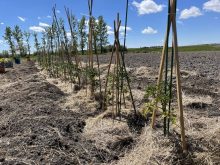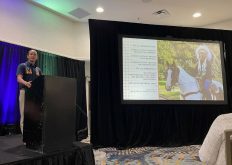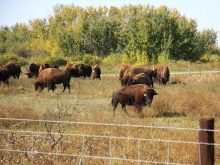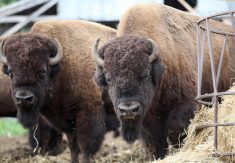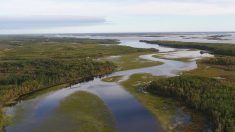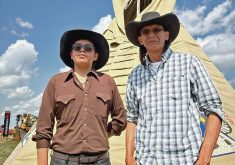The dictionary definition of reconciliation is “restoration of friendly relations” and “the action of making one view or belief compatible with another.”
When it comes to truth and reconciliation with Indigenous peoples in Canada, it goes beyond a few days of recognition, advocates say. It’s about leaving space for economic reconciliation too, including greater inclusion of Indigenous people, communities and businesses in the Canadian economy, as well as Indigenous values and practices.
Why it matters: Like other industries in Canada, agriculture is wrestling with its view of reconciliation and how to put it into action.
Read Also

Journal pulls long-cited glyphosate study for ethics violations
The journal Regulatory Toxicology and Pharmacology has retracted a 2000 Monsanto-linked glyphosate review, drawing new scrutiny as Bayer faces mounting legal pressure.
Agriculture could be a big driver of that.
Speaking at a Protein Industries Canada event in September, Cadmus Delorme, chief executive officer and partner of OneHoop Consulting, flagged the need for agriculture and agri-food sectors to foster Indigenous connection and partnership and leave room for Indigenous opportunity.
He cited the Cowessess First Nation in southeastern Saskatchewan, where he was previously chief. The First Nation has grown its agricultural operation to 8,000 acres, run by five Indigenous producers who have non-Indigenous farmers as mentors.
The connection has resulted in economic and agricultural growth for the community, he said.
Duplicating that success means going back to the fundamentals, said Chris McKee, senior vice-president of business development at the National Circle for Indigenous Agriculture and Food. Be a good neighbour and recognize the role of everyone in agriculture.
“We’re here to feed the world, and we are in the agricultural mecca for being able to do that. And we’re not going to do it alone, we need to do this collaboratively,” he said.
Economic reconciliation benefits both Indigenous and non-Indigenous, he added, citing long-term effects like revenue sharing, job creation and community development. Incorporating multiple perspectives in decision making can create strong, sustainable land use and resource management.
A growing sliver
A federal agriculture survey in 2021 showed 2.8 per cent of Canada’s farm population identified as First Nations, Métis or Inuit. That’s a small cross-section of Canada’s farmers, but it’s also been growing.
From 2016-21, Statistics Canada said the Indigenous farm population had risen six per cent. The proportion of that farm population with educational certification also rose. Almost 62 per cent had a high school diploma or equivalent, trades certification or post-secondary diploma or degree in 2021. In particular, more Indigenous farmers had a bachelor’s degree or higher.
Looking in the mirror
The connection starts with the difficult first step of approaching Indigenous communities and partners, McKee noted.
“Lots of times we have a fear of approach or a fear of offending, so we don’t stop in a community or a band office or at a business that’s different than what we’re used to,” he said.
“But in order to build that economic reconciliation as the end goal, we have to establish those relationships. We need to reach out, we need to express interest in collaboration and we need to build those personal relationships, not an email, not a chat on the web.”
His organization is among those looking to get relationships off the ground. The circle’s mandate is to connect potential Indigenous and non-Indigenous partners. McKee likened it to being introduced to someone at an event through a mutual friend.
Before non-Indigenous parties can be good business partners, there must be a “reconciliation of self,” he added.
He described that as self reflection and getting educated on Indigenous circumstances and history.
Celine Favreau, chief executive officer of NWC Wild Rice Company, said she’s learned a lot about reflection and cultural awareness during her time in northern Saskatchewan. The company is owned by seven Métis municipalities in the province’s northwest and works with generational wild rice farmers in the region.
Communication and understanding have been the most beneficial skills, she said, along with conscious effort to ensure equal opportunities are available.
“Make sure that everybody is on the same playing field and to be conscious of what thing do we benefit from or what benefits do we have that secure our position, and how can we make sure that those apply to everybody? Or, if there’s some imbalances, what can we do?’”
The company has dedicated pre- and post-harvest meetings to that end. It is also working to establish an Indigenous wild rice harvesters association to provide that sector with an organized voice.
“Really, it’s about being aware and respectful of interest in land-based economies and what that means to people,” she said. “I guess being more culturally aware. And the only real, true way to become more culturally aware is by connecting with people and language.”
Her personal strategies include making acquaintances and friendships, connecting with people on social media, and connecting with different news sources.
Next steps can be big or small
McKee said engaging in Indigenous culture can start small. Go to a powwow, cultural teaching or ceremony, support an Indigenous business, or go to a learning workshop, he suggested.
“Show a genuine interest in the traditions and the community activities, no different than you would a slow-pitch tournament or a fall supper. They are exactly the same, and we are 100 per cent no different.”
If anyone in agriculture is ready for a deeper step, there are options, he said, but the form those next steps take comes down to an individual’s goals and intentions.
Agriculture businesses should ask themselves what steps need to be taken, what barriers may exist for the community or individual they’re looking to partner with or pass their business to, and what solutions may work best for them.
“Any business that does a merger, they’ve always got a plan that leadership stays on for one to three years, and (that) lets people know what’s happened, what’s the history, what’s going on. Why are we doing it the way we do? We need to start doing that more in agriculture. Agriculture is a business.”
He also noted the role of mentorship between Indigenous and non-Indigenous people is part of successful partnerships. It incorporates the ability to explain intentions and allows both sides to ask questions and learn.
A previous version of this story wrongly cited Cowessess First Nation as farming 80,000 acres.




